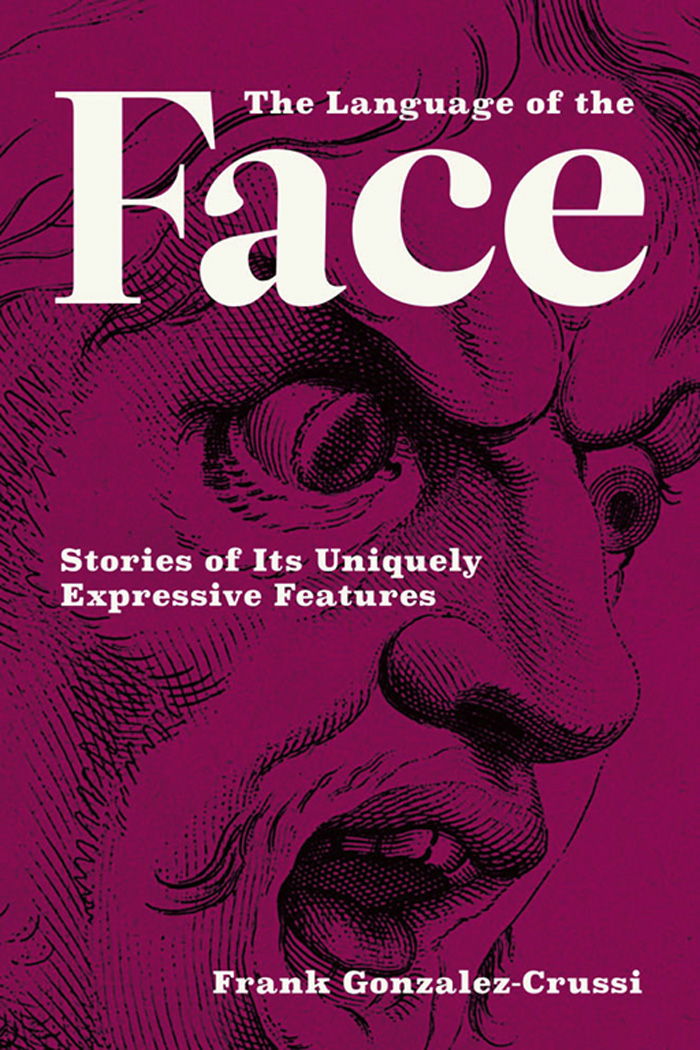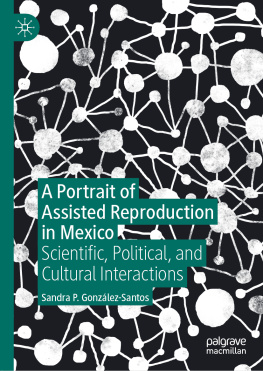
The Language of the Face
The Language of the Face
Stories of Its Uniquely Expressive Features
Frank Gonzalez-Crussi
The MIT Press
Cambridge, Massachusetts
London, England
2023 Massachusetts Institute of Technology
All rights reserved. No part of this book may be reproduced in any form by any electronic or mechanical means (including photocopying, recording, or information storage and retrieval) without permission in writing from the publisher.
The MIT Press would like to thank the anonymous peer reviewers who provided comments on drafts of this book. The generous work of academic experts is essential for establishing the authority and quality of our publications. We acknowledge with gratitude the contributions of these otherwise uncredited readers.
This book was set in Adobe Garamond Pro by New Best-set Typesetters Ltd.
Library of Congress Cataloging-in-Publication Data is available.
ISBN: 978-0-262-04753-1
10987654321
d_r0
Contents
Introductory Note
At least since the classical era, the idea that human beings are double has enjoyed very wide currency. According to this idea, each of us is divisible into two: an exterior being that all can see, and an interior being that lies hidden. Of the others we see the surface only; we know not what is going on in the realm of consciousness. The psychic agitations of our fellowswhether minor stirrings or severe, convulsive disarrayare generally undetectable to us. Similarly, our own inner commotions are concealed to outsiders. Still, the hidden inside and the visible outside are not wholly divorced from each other; some communication exists between the two. The proof is that some movements of the inside do reach the outside and show through, primarily in the face. Centuries-old observation taught us that we have legible countenances, like open books. We can discern, by examination of the exterior changes, what is happening to the inner being. But this is true in a limited way, and of the fleeting emotions only, which appear one moment and disappear the next.
We are curious; we would like to know more; we would like to find out the whole structure of our neighbors character. But how are we to achieve this? We are not as fortunate as Peregrinus Tyss, a fictional personage in one of E. T. A. Hoffmanns fantasy stories, Master Flea, who is given a magnifying lens that can be inserted in front of the left pupil (a sort of contact lens precursor), whereby the wearer can see across the cranial bones into the brainand actually read the thoughtsof the persons with whom he is talking. Lacking this magical resource, we are forced to try to discern other peoples thoughts and emotions by inference. We can see that passing moods, good or evil, end up stamping their impress upon the face by constant reiteration. Each passion has a distinctive expression. The folds of the skin produced by smiling become imprinted on the face; similarly, the wrinkles of frowning remain fixed. Hence the desire grew to build a whole science that might disclose to us the hidden character of a human being through the study of his or her external features.
This is how physiognomy was born. It was originally called physiognomony (from the Greek physis, , nature, and gnomon, , interpretation), which the Oxford English Dictionary says is the etymologically correct term, although it has been contracted in all the Romanic languages, and still more in English. Initially, physiognomy was considered a twofold science: one part was designed as a way to discriminate character by the faces outward appearance; the other, as a method of divination based on outward form and feature. As late as the eighteenth century, physiognomys double purpose was generally acknowledged. Samuel Johnsons dictionary defined physiognomy as The act of discovering the temper and foreknowing the fortune by the features of the face. Relegated to a second place is the acceptation that has survived to our day, which Samuel Johnson formulates laconically: The face; the cast of the look.
The Messiah of physiognomy in the Enlightenment era was the Swiss writer, mystic, pastor of the Zwinglian Church, illuminist, poet, and would-be scientist Johann Caspar Lavater (17411801). An enormously influential figure in this time, he was genuinely convinced that he had founded the science or knowledge of the correspondence between the external and internal man, the visible superficies and the invisible contents.
Fortune-telling is the most colorful aspect of this discipline, but also the likeliest to lend itself to abuses. English law understood this well: an act of Parliament in 1743 decreed that all persons pretending to have skill in (divinatory) physiognomy should be declared rogues and vagabonds, liable to be whipped, or subject to incarceration until next sessions. Act 39 under Queen Elizabeth (15971598) specified that one claiming to be expert in physiognomy or like Fantasticall Ymaginaciouns was liable to be stripped naked from the middle upward and openly whipped until his body be bloudye. The British Queen may have tolerated orthographical shilly-shallying from her Parliamentarians, but when it came to implementing rigorous, unpitying laws, everyone knew Gloriana was not in the habit of kidding.
The present book is not intended as a treatise on the history of physiognomy. An enormous bibliography on this theme is already extant. Rather, the material presented here consists of literary and historical narratives, artistic expressions, biomedical notions, and philosophical reflections woven around physiognomy during the eventful history of the face-reading pseudoscience. My idea has been to broaden the readers appreciation of this subject matter by using a multiplicity of sources. The traditional essay format seemed specially fitting to this endeavor, since it enables an author to move freely across various disciplines, such as artistic, literary, and medical treatises. This approach no doubt has some drawbacks, but also distinct advantages. The multiplicity of viewpoints and the originality of fresh and unaccustomed ideas thus presented is likelier to make a reader question his wonted notions and habitual prejudices than a work built upon a meager documentary support.
In choosing the title of this book, the idea came to me to name it an anthology. However, anthology signifies, according to most dictionaries, a collection of choice literary pieces or passages, or selected pieces in any art form; its etymology (from Greek flower + to gather) implies a deliberate compilation of the best, most representative, or prettiest specimens: truly a gathering of flowers. In contrast, much of the miscellaneous amassment in the present work is accessory or subsidiary to the history of physiognomy. Some of it may seem but tenuously related to this subject, yet it contributes, I believe, to its embellishment and enhances its interest. Accordingly, an appropriate title for this book might have been Parerga on Physiognomy, since the word parerga (plural of parergon), as the OED further informs us, derives from the Greek beside + work, that is to say, a by-work, something subordinate or secondary to the main topic. Except that parerga, like physiognomony, being a Greek term, naturally sounds Greek, and, frankly, is still Greek to most of us.
Thus, the reader will find here, instead of a detailed description of the astrological methods used by early physiognomists to forecast a persons future, a lively biographical semblance of the most colorful forecaster of all; instead of the anatomical minutiae alleged to confer character on a nose, amusing stories centered upon noses of all types; and in lieu of an extensive coverage of the modern scientific explanations of facial attractiveness, old narratives of the calamitous effects of beauty and the ways contrived by previous ages to fall out of love. Admittedly, the books plan is idiosyncratic. Colorful anecdotes share space equitably with more serious dissertations. Reports from the specialized sociological or medical literature were not excluded. The only exclusionary criterion applied was boredom. It is my most earnest hope that the reader will not find my selection criteria wholly ill-advised.
Next page










